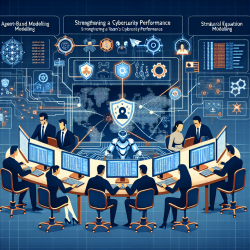Introduction
In the rapidly evolving field of cybersecurity, the formation and performance of teams play a critical role in defending against cyber threats. The recent research article titled CCTFv2: Modeling Cyber Competitions provides valuable insights into optimizing team performance in cyber competitions. This blog explores how practitioners can leverage these findings to enhance their skills and outcomes in cybersecurity contexts.
Understanding Cyber Team Dynamics
Cyber competitions, such as Capture the Flag (CTF) events, are increasingly popular platforms for honing cybersecurity skills. However, the dynamics of team formation and performance in these competitions have not been extensively studied. The CCTFv2 research addresses this gap by employing a cross-validating two-approach methodology, combining computational modeling with theoretical frameworks from team performance literature.
Key Findings from CCTFv2
The research identifies two primary findings:
- The existing literature on team dynamics is applicable to cyber competitions, validating the use of established theories in this context.
- Coaches and researchers can utilize computational models to test new team strategies and predict performance outcomes with precision.
These findings underscore the importance of strategic team formation and the potential for computational tools to enhance team effectiveness in cybersecurity settings.
Implementing Research Insights
Practitioners can apply the insights from CCTFv2 in several ways:
- Leverage Computational Models: Use agent-based modeling to simulate team dynamics and test different formation strategies. This approach allows for the evaluation of various configurations without real-world consequences.
- Focus on Collaboration: The research highlights the critical role of collaboration in team performance. Practitioners should foster environments that encourage open communication and teamwork.
- Strategic Team Formation: Consider factors such as team size, skills, and role distribution when forming teams. Tailoring team composition to specific objectives can enhance performance.
Encouraging Further Research
While CCTFv2 provides a solid foundation, there is still much to explore in the realm of cyber team dynamics. Practitioners are encouraged to engage in further research to refine models and strategies, contributing to the broader understanding of effective team formation in cybersecurity.
Conclusion
The insights from CCTFv2 offer a valuable framework for enhancing team performance in cyber competitions. By integrating computational models with established theories, practitioners can optimize team dynamics and achieve better outcomes in cybersecurity contexts.
To read the original research paper, please follow this link: CCTFv2: Modeling Cyber Competitions.










